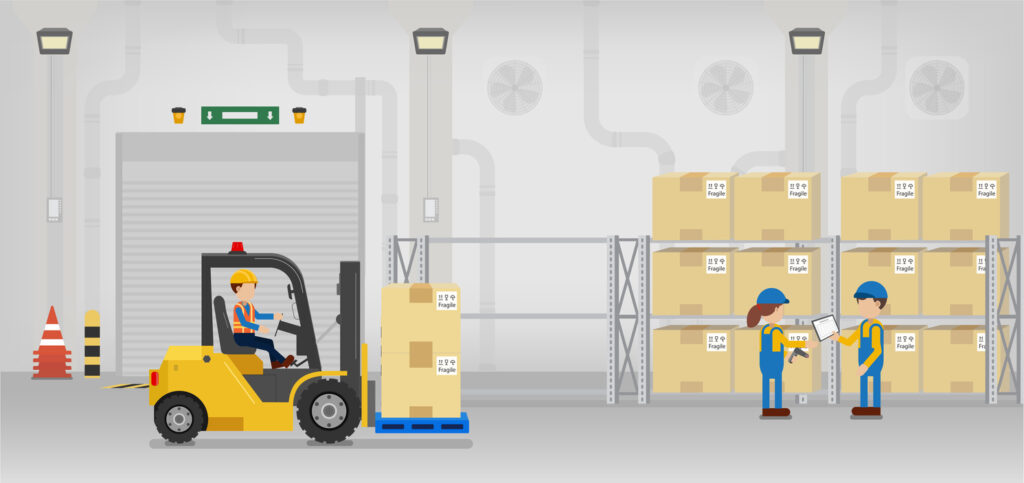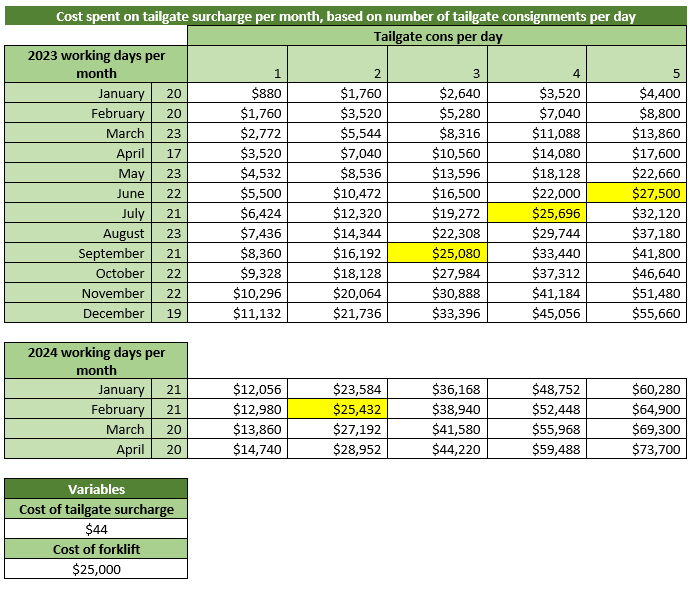Is a forklift a worthwhile investment for my business?

In order to load freight weighing more than 30kgs on and off a vehicle, mechanical assistance is required, either by utilising a tailgate truck or a forklift. This is a requirement of most transport carriers in an effort to protect drivers from injuries related to lifting heavy items. While forklifts can have significant upfront costs, businesses regularly sending heavy freight may opt to invest to save money on tailgate surcharges in the long term.
Why wouldn’t I just book my freight to be picked up by a tailgate vehicle to avoid the upfront cost of a forklift?
Depending on a range of variables, including the number of consignments over 30kgs you send per day, the tailgate surcharge price set by the carriers you are using, and the cost of a forklift suited to your business, it may be a more cost-effective option in the long term to invest in a forklift.

We have created the example above to showcase the benefit to a business sending more than 2 consignments over 30kgs per day if they were to purchase a forklift at the beginning of January 2023. We have set the tailgate surcharge price at $44, and the cost of a forklift at $25,000. You can see:
- If you have two tailgate consignments per day, you will begin saving money due to your forklift investment in February 2024.
- If you have three tailgate consignments per day, you will begin saving money due to your forklift investment in September 2023.
- If you have four tailgate consignments per day, you will begin saving money due to your forklift investment in July 2023.
- If you have five tailgate consignments per day, you will begin saving money due to your forklift investment in June 2023.
Not captured in this calculation, you also need to factor in the costs of maintaining the forklift, running the forklift if it is battery rechargeable or uses diesel or petrol, and you will need a staff member with a forklift licence to operate the vehicle.
Your Myfreight Account Manager can help analyse the cost and return on investment of purchasing a forklift.
Should I invest in a forklift? What are my other options?
The most common drawback we hear our customers discussing when considering investing in a forklift is the upfront cost. To mitigate this, many of our customers have had success investing in a second-hand forklift.
Some customers who only require a forklift for a short period have found it more cost effective to hire one or borrow from a neighbouring business.
You could also consider cheaper alternatives, like a walkie stacker/pallet stacker, however, keep in mind that these often have lower load capacity and lift height than forklifts.
What should I consider before purchasing the forklift or walkie stacker?
To determine your business requirements for a forklift or walkie stacker, we recommend considering:
- How high will you need to lift?
- Will the forklift or walkie stacker be used mainly indoors or outdoors?
- Will the forklift or walkie stacker comfortable fit and manoeuvre around the aisles of your business or warehouse?
- What kind of tyres will be required?
- Do you have someone qualified to operate a forklift? Or is someone able to be trained and obtain a license?
Can I break down pallets into individual cartons to avoid tailgate surcharges?
Sometimes businesses ask whether instead of consolidating their freight onto one pallet which is heavy enough to attract a tailgate surcharge if they can just send loose cartons (not palletised) as each individual carton is less than 30kgs.
While in some circumstances businesses can get away with this, we would advise against it.
Unpalletised freight can, in some cases, reduce your transport carrier options depending on the location of your premises. Industrial areas, for example, are typically serviced by “bulk” trucks and are not equipped to carry large amounts of loose cartons. As such, transport providers may opt not to service businesses in these types of areas that are not able to palletise their freight.
In addition to this, if a transport provider does accept the consignment, depending on the transport provider they may track the time spent manually loading freight onto their vehicle once they reach the pickup address. By creating extra work for the driver, you may be charged with unexpected loading fees.
As a general rule, if you wish to maintain a close relationship with the drivers who service your area, we recommend making the freight collection from your business as straight forward as possible. Many delivery drivers have an extensive list of collections to make in their area, and if they have a poor experience or feel a business isn’t following correct procedure, they will be less inclined to prioritise collecting freight from that business.
